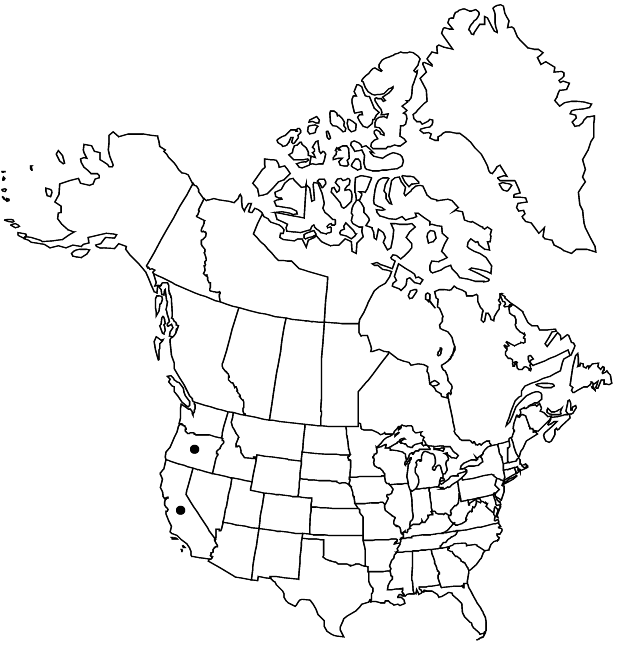Difference between revisions of "Lithophragma affine"
Proc. Amer. Acad. Arts 6: 534. 1865 (as affinis) ,.
FNA>Volume Importer |
imported>Volume Importer |
||
| (6 intermediate revisions by 2 users not shown) | |||
| Line 7: | Line 7: | ||
}} | }} | ||
|common_names=San Francisco woodland star | |common_names=San Francisco woodland star | ||
| + | |special_status={{Treatment/ID/Special_status | ||
| + | |code=E | ||
| + | |label=Endemic | ||
| + | }} | ||
|basionyms= | |basionyms= | ||
|synonyms={{Treatment/ID/Synonym | |synonyms={{Treatment/ID/Synonym | ||
|name=Lithophragma affine subsp. mixtum | |name=Lithophragma affine subsp. mixtum | ||
|authority=Roy L. Taylor | |authority=Roy L. Taylor | ||
| − | }}{{Treatment/ID/Synonym | + | |rank=subspecies |
| + | }} {{Treatment/ID/Synonym | ||
|name=Lithophragma catalinae | |name=Lithophragma catalinae | ||
|authority=Rydberg | |authority=Rydberg | ||
| − | }}{{Treatment/ID/Synonym | + | |rank=species |
| + | }} {{Treatment/ID/Synonym | ||
|name=Lithophragma intermedium | |name=Lithophragma intermedium | ||
|authority=Eastwood ex Small & Rydberg | |authority=Eastwood ex Small & Rydberg | ||
| − | }}{{Treatment/ID/Synonym | + | |rank=species |
| + | }} {{Treatment/ID/Synonym | ||
|name=Lithophragma trifidum | |name=Lithophragma trifidum | ||
|authority=(Greene) Greene | |authority=(Greene) Greene | ||
| − | }}{{Treatment/ID/Synonym | + | |rank=species |
| + | }} {{Treatment/ID/Synonym | ||
|name=Lithophragma tripartitum | |name=Lithophragma tripartitum | ||
|authority=(Rydberg) Fedde | |authority=(Rydberg) Fedde | ||
| − | }}{{Treatment/ID/Synonym | + | |rank=species |
| + | }} {{Treatment/ID/Synonym | ||
|name=Tellima catalinae | |name=Tellima catalinae | ||
|authority=(Rydberg) Fedde | |authority=(Rydberg) Fedde | ||
| − | }}{{Treatment/ID/Synonym | + | |rank=species |
| + | }} {{Treatment/ID/Synonym | ||
|name=Tellima intermedia | |name=Tellima intermedia | ||
|authority=Greene | |authority=Greene | ||
| − | }}{{Treatment/ID/Synonym | + | |rank=species |
| + | }} {{Treatment/ID/Synonym | ||
|name=Tellima tripartita | |name=Tellima tripartita | ||
| − | |authority= | + | |authority= |
| + | |rank=species | ||
}} | }} | ||
|hierarchy=Saxifragaceae;Lithophragma;Lithophragma affine | |hierarchy=Saxifragaceae;Lithophragma;Lithophragma affine | ||
| Line 47: | Line 59: | ||
|elevation=0-2000 m | |elevation=0-2000 m | ||
|distribution=Calif.;Oreg. | |distribution=Calif.;Oreg. | ||
| − | |discussion=<p>Flowering in Lithophragma affine is dependent upon sufficient rainfall. Often-abundant vegetative reproduction is by aerial or subterranean bulbils. The southern California specimens form a polymorphic complex related to the topography of the region, seasonal precipitation, and reproductive biology. The north-coastal distribution is complicated by introgression with L. parviflorum. Similar transitional forms occur in central coastal California to the Sierra Nevada foothills.</p><!-- | + | |discussion=<p>Flowering in <i>Lithophragma affine</i> is dependent upon sufficient rainfall. Often-abundant vegetative reproduction is by aerial or subterranean bulbils. The southern California specimens form a polymorphic complex related to the topography of the region, seasonal precipitation, and reproductive biology. The north-coastal distribution is complicated by introgression with <i>L. parviflorum</i>. Similar transitional forms occur in central coastal California to the Sierra <i>Nevada</i> foothills.</p><!-- |
| − | --><p>The Mendocino Indians used the root of Lithophragma affine to treat colds and stomach aches (D. E. Moerman 1998).</p> | + | --><p>The Mendocino Indians used the root of <i>Lithophragma affine</i> to treat colds and stomach aches (D. E. Moerman 1998).</p> |
|tables= | |tables= | ||
|references= | |references= | ||
| Line 57: | Line 69: | ||
-->{{#Taxon: | -->{{#Taxon: | ||
name=Lithophragma affine | name=Lithophragma affine | ||
| − | |||
|authority=A. Gray | |authority=A. Gray | ||
|rank=species | |rank=species | ||
| Line 71: | Line 82: | ||
|publication title=Proc. Amer. Acad. Arts | |publication title=Proc. Amer. Acad. Arts | ||
|publication year= | |publication year= | ||
| − | |special status= | + | |special status=Endemic |
| − | |source xml=https:// | + | |source xml=https://bitbucket.org/aafc-mbb/fna-data-curation/src/2e0870ddd59836b60bcf96646a41e87ea5a5943a/coarse_grained_fna_xml/V8/V8_155.xml |
|genus=Lithophragma | |genus=Lithophragma | ||
|species=Lithophragma affine | |species=Lithophragma affine | ||
Latest revision as of 22:41, 5 November 2020
Plants robust. Flowering stems simple, 20–55 cm. Leaves in basal rosette and cauline, basal leaves 3–5-lobed, cauline (1–3), deeply 3-lobed, usually reduced, similar to basal; stipules narrow, not decurrent on petiole base, (margins fimbriate); petiole to 22 cm; blade dark green, orbiculate to reniform, (base cordate), surfaces variously hairy. Inflorescences 1–9(–15), (often lax), nodding racemes, simple, 3–9(–15)-flowered, (10–60 cm). Pedicels equaling or shorter than hypanthium. Flowers deciduous if unfertilized, not fragrant, horizontal; hypanthium obconic, elongating in fruit, throat constricted or partially open, (length 2 times diam.); sepals erect, often remaining slightly erect in fruit, triangular; petals (exserted), not widely spreading, white with obscure venation, ovate-elliptic, narrowly clawed, usually shallowly 3-lobed, rarely unlobed, (sinuses extending to 1/2 distance to base), 4–13 mm, ultimate margins entire, sometimes with extra tooth, (lobes acute); ovary ± completely inferior; styles included in fruit; stigma papillae in narrow subapical, sometimes apical bands. Seeds 0.5–0.6 mm, smooth, sometimes rough. 2n = 14, 21, 28, 35.
Phenology: Flowering Mar–May.
Habitat: Coastal mountains, open, well-drained, grassy slopes, clearings, open bluffs in oak or coniferous-oak woodlands, sometimes in semishade or coastal north-facing canyons
Elevation: 0-2000 m
Discussion
Flowering in Lithophragma affine is dependent upon sufficient rainfall. Often-abundant vegetative reproduction is by aerial or subterranean bulbils. The southern California specimens form a polymorphic complex related to the topography of the region, seasonal precipitation, and reproductive biology. The north-coastal distribution is complicated by introgression with L. parviflorum. Similar transitional forms occur in central coastal California to the Sierra Nevada foothills.
The Mendocino Indians used the root of Lithophragma affine to treat colds and stomach aches (D. E. Moerman 1998).
Selected References
None.
